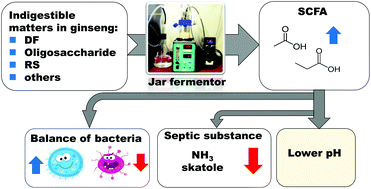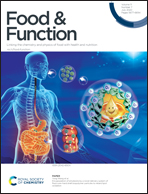In vitro fermentation potential of the residue of Korean red ginseng root in a mixed culture of swine faecal bacteria†
Abstract
Agricultural by-products such as the ginseng residue contain dietary fibre. This study was aimed at investigating the intestinal fermentation potential of the residue of Korean red ginseng root using an in vitro simulator of the colon using swine fecal bacteria. pH-Controlled glass fermentors were used to conduct a small scale in vitro batch fermentation under anaerobic conditions for 48 h. One of the following substrates was included in each fermentor: commercial cellulose (CEL), xylooligosaccharide (XOS), and crude ginseng-insoluble fibre (CGF). The pH was lower (p < 0.05) and the production of total short chain fatty acid was increased (p < 0.05) in the XOS and CGF groups compared with the CEL group after 6 h of incubation. The α-diversity analysis of the microbial community at 48 h showed that the number of bacterial species was (p < 0.05) reduced in the XOS and CGF groups compared with that in the CEL group. β-Diversity of the microbial population at 48 h showed that all groups were clustered differently. The relative abundance of Bifidobacterium and Prevotella in the CGF group were significantly (p < 0.05) higher than those in the CEL and XOS groups. Ammonia nitrogen production in the XOS and CGF groups was (p < 0.05) lower after 6 h of incubation, and skatole production in the CGF group was (p < 0.05) lower at 48 h than that in the CEL group. These results suggested that the ginseng residue might be fermentable in the large intestine and thus would promote the maintenance of a healthy colonic environment in the host.



 Please wait while we load your content...
Please wait while we load your content...